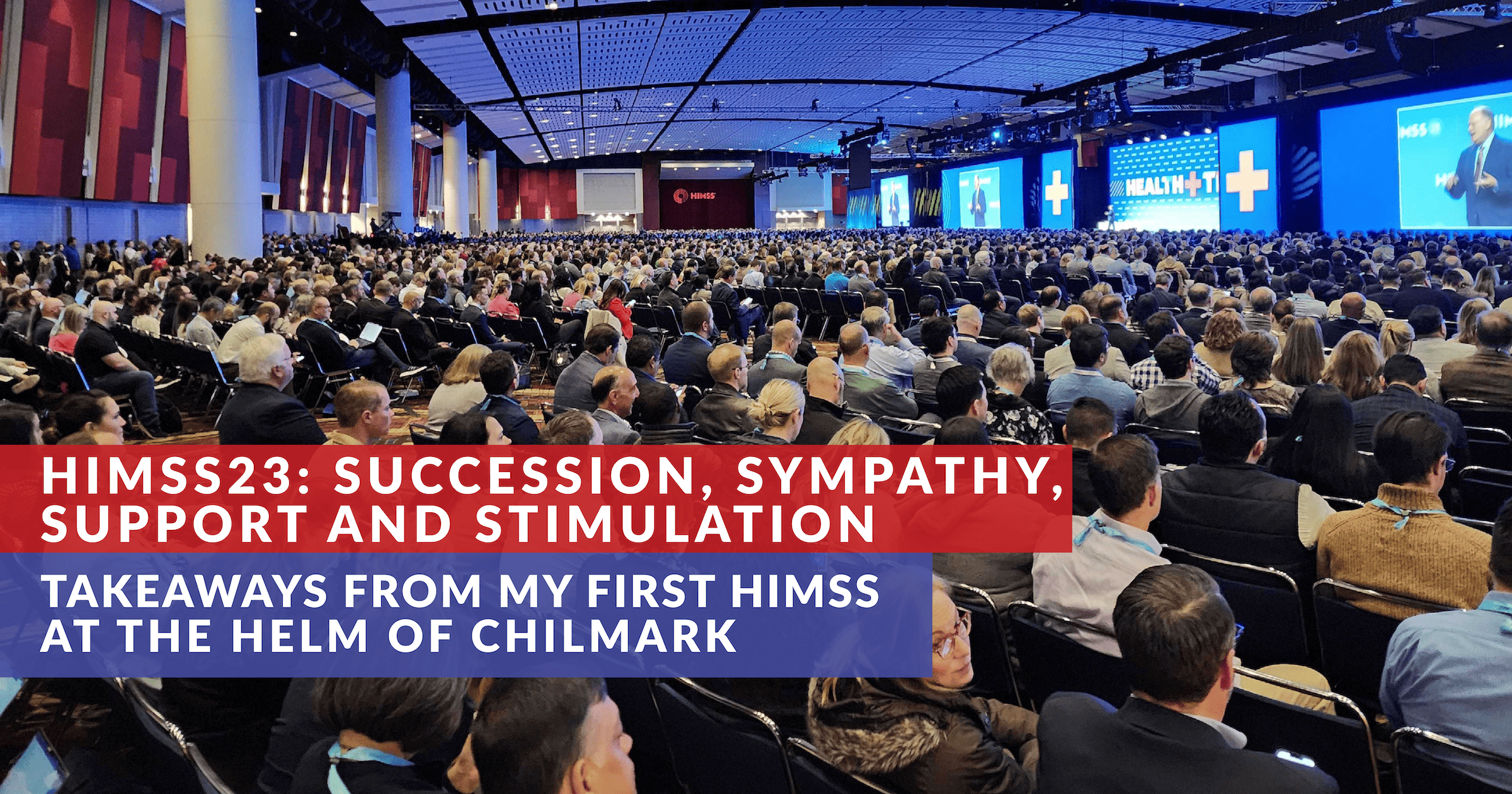Industry leaders reflect on the ‘post-COVID’ state of the market and what’s next for health IT
The dust is clearing from another edition of the annual HIMSS conference, this time much closer to its pre-COVID attendance numbers than the 2021 event, and with a full exhibitor hall. And for the first time since 2019, the entire Chilmark team made the trip to Orlando to meet with a swath of vendors and other industry leaders to take the pulse of what’s happening in the world of healthcare IT.
As we look to the future of the space, there are several clear trends and hot topics that emerged in our many discussions across the team. In addition to my standard relationship-nurturing work onsite, I took time to set up a number of interviews with various executives and thought leaders to share their perspectives with the rest of the community directly as part of our video and podcast series (Apple, Spotify, Google, Stitcher).
Below is a preview reel of who we met with and what we discussed, highlighting some of the key points made during these conversations:
Interoperability was a word on the lips of many data vendors; patients often not having access to their own data has become a glaring issue that organizations can no longer afford to overlook. Between new legislation (TEFCA, Data-blocking rules) and louder calls for data liquidity from consumers and other stakeholders, the community is clearly trying to change the paradigm, but legacy thinking and legacy systems are still creating roadblocks to true interoperability.
Tied to this need for interoperability was the common discourse around how the lack of system to system communication is detrimental to the industry’s ability to create a better understanding of a patient’s full care journey by incorporating external data points. Long-term and post-acute care (LTPAC) and especially social determinants of health (SDoH) came up over and over again; addressing these problems that we’ve known to exist for a long time in healthcare (and society) finally seems possible, albeit still a future-state of the market. There was tangible excitement for the potential of new standards and regulatory requirements to finally remove some of these oft-cited kinks in the system.
We’ll be rolling out the full videos from our interview series over the coming weeks, so stay tuned! In the meantime, here’s a list of the thought leaders in healthcare IT that we met with while on-site:
- Jonathan Bush, CEO, Zus Health
- Joe Gagnon, CEO, 1uphealth
- Anthony Laflen, Acute and Payer Industry Market Leader, PointClickCare
- Mike McSherry, CEO, Xealth
- Bevey Miner, Global CMO, Consensus Cloud Solutions
- Matt Parker, SVP Product, Kyruus/HealthSparq
- Lisa Shubitowski, System Director Interoperability, Hartford Health Care
- Paul Wilder, Executive Director, CommonWell Health Alliance
- Gabriela Wilson, Ph.D., Co-Director, Multi-Interprofessional Center for Health Informatics
AI-generated Transcript:
Paul Wilder: [00:00:13] A lot of mistakes are made in health care and you just don’t know about it. And I believe that the human, the patient, the consumer is the ultimate arbiter of their data and the person that cares the most about it. And we’ve had years of portals and low adoption of them because they don’t work well. We need to plug patients into the networks the providers already plugged into.
Gabriela Wilson: [00:00:35] We are losing health care workers because of the burden of what they had to go through. And we all understand why. But this doesn’t mean you have to give up your passion of serving people, right? And caring about people. So in this area of informatics, public health informatics, health informatics, these are the most valuable people to really learn what data is necessary to understand better the community needs.
Mike McSherry: [00:01:06] Certainly understanding how clinicians, doctors, nurses, MAs, I mean, they carry the workload of the health and safety of this country on their backs and especially as we’ve seen during COVID. And so you get inspired by that. And yet you also see all their manual processes and they’re laboriously, you know, kind of level of efforts where digital and technology automation does not help them.
Gabriela Wilson: [00:01:29] Look, innovation happens every day. And the fact that we are forced to be at home, it didn’t mean that we had to stop innovating. And as an educator, I couldn’t be more excited about the needs of better education, better training, better research so we can help our communities.
Jonathan Bush: [00:01:50] I don’t believe that health care has experienced network effect. I don’t believe that the magic of multiple entities making a network stronger and stronger and seeing order of magnitude more value for their efforts by virtue of their connection to others kicking in yet. It’s all kind of a top down sort of waterfall type approach to management and care delivery.
Joe Gagnon: [00:02:17] Like everyone says, “Well, the reason that you can’t have transparency and priorities because we really don’t know what it’s ultimately going to cost.” You know, well, you got an airplane, they don’t really know how much it’s going to cost you to land that plane because they might be using more jet fuel flying around because there’s a tornado, right? We just can build that into the risk model, into the pricing model. We can do that with more data. We can be smarter about this and we can overcome any objection to do this better.
Anthony Laflen: [00:02:43] This creates a massive hive of information that could be shared across the continuum. And again, back to my point about high, acute populations, these are the people everybody wants to see. When you hear readmissions, they’re focused on this population. When you hear about length of stay, these are the folks that they’re trying to make sure we have an appropriate utilization level.
Bevey Miner: [00:03:00] And while we might not think that prior authorizations are a part of this world we call interoperability. But the merits very much are because you are disrupting that continuity of care when a patient’s at the glass, at the pharmacy waiting to get their prescription and it hasn’t been authorized because some sort of step therapy had to happen. And the patient’s like, “Well, wait a minute, I can’t get it.” “Oh, yeah, come back tomorrow. We’ll get your prior authorization.” And they don’t go back, they don’t comply or you end up with a prior authorization that’s got some really critical information in it.
Jonathan Bush: [00:03:31] What I think established providers are going to struggle with is if somebody is an omnichannel patient, if somebody is touching care both in and outside of their kind of data moat, can they handle them properly with the current technology environment or do they need to refer to some sort of system of patients record?
Anthony Laflen: [00:03:57] If the connection is in place and a patient is headed my way into my skilled nursing home, I can go into an inbound tab endpoint, click here. And when I click on your name, John, I can see all the documentation that the hospital actually recorded for you, the history and physical, the speech information, all of your therapy nodes, all of your medications, all of that. The single click. I can pull it in and pull handoff. Yeah, it cuts the admission time down from an hour and a half to about 15 to 20 minutes.
Mike McSherry: [00:04:23] Because one thing that we do have is 4 to 10x higher adoption when it’s that doctor recommending something to a patient than the employer recommending some something to their employee base or the payer even suggesting like, John, you really need to manage this and people don’t trust the insurance. “Why are you trying to get me to do this?” But if the doctor says that people will more readily accept it here, especially when they know that clinician is looking over their shoulder at the data stemming from that app or tool or program to know if the patient is being adherent to that.
Bevey Miner: [00:04:56] We have to get people digital, get them digital, meet them where their maturity is. We get them on an electronic document just like we did back in 2007, eight and nine. Getting physicians onto an electronic health record. The possibilities are endless because intelligence in those documents now can be extrapolated so that you can do so, so much more with it.




0 Comments